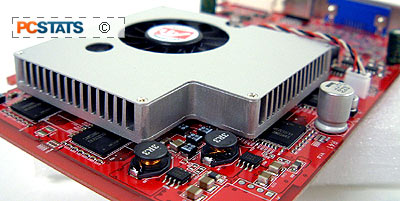PowerColor X700 PRO Videocard Review
Call me a
snob, but I until recently I never would have considered using anything but a high end card in
my main computer. Yey, now that I look around, the mainstream videocards of today
are really starting to appeal to me; with decent performance and wallet friendly prices they are quite attractive.
Videocards
based on the ATi Radeon X700 VPU and nVIDIA GeForce
6600 GPU are extremely quick, and offer a great deal of value. In many instances, these new
mainstream cards are as fast, or faster than the previous generation's top of
the line models. This is quite significant when you consider that
historically it has taken two generations (or sometimes more) for a high-end card to
fall to mainstream performance levels.
If you
were to compare the specs of the ATI Radeon X700 to the nVidia
GeForce 6600 cores, ATi comes out on top ever so slightly due to the potentially
stronger vertex engine. With six vertex rendering pipelines, the Radeon
X700 should beat out the GeForce 6600 in rendering images that have a lot of
polygons.
In this
review PCSTATS is testing out the PowerColor
X700 PRO videocard, which is
obviously based around the Radeon X700 Pro VPU. The videocard is native to PCI
Express, using the PCI Express 16x slot. It comes packing 128MB of Samsung
GDDR3 memory, and that runs on a 128bit memory bus. A similar solution by Gigabyte (the GV-RX70P256V) used a
passive heatsink, but the PowerColor X700 Pro uses an active cooling solution. It is still very quiet, and
you're unlikely to notice this card once it's installed and running into your PC.
Powercolor's software bundle includes CyberLink's DVD solution software
with PowerDirector SE+, MediaShow SE, PowerDVD, PowerProducer DVD and Power2Go. Also thrown into the
mix is a copy of Hitman Contracts, an older game, but still a lot of
fun.
The unit on PCSTATS test bench
has 128MB of memory, which is why you see the silk screened spots on the back
for four more BGA DRAM modules. There's no performance difference between the
128MB and 256MB models though, and the PowerColor X700 PRO has more than enough
memory to handle the latest games.
 The Radeon X700 PRO VPU does
not generate a lot of heat, so PowerColor can cool the core with a small
aluminum HSF. The heatsink does not cover the memory. GDDR3 modules run pretty
cool by default. Even when overclocked, the Samsung BGA memory modules were only
mildly warm to the touch.
The Radeon X700 PRO VPU does
not generate a lot of heat, so PowerColor can cool the core with a small
aluminum HSF. The heatsink does not cover the memory. GDDR3 modules run pretty
cool by default. Even when overclocked, the Samsung BGA memory modules were only
mildly warm to the touch.
We were pleased to see ATi
integrate component output support into the Radeon X700 core. Every X700-based
card owner should have not have any problem connecting to HDTV sets with the
included set of component cables (Y, Pb, Pr). Along side that comes an
S-Video-to-S-Video cable, composite-composite cable and a two way
composite-S-Video cable for regular TV sets. The PowerColor X700 PRO's bundle
does not include any kind of breakout box for these outputs; instead, all the
cables connect to a single proprietary 'tv-out' connector on the mounting
bracket. Users only have the option of using one or the other cable type.
I was impressed to see how
well detailed and thorough the PowerColor X700 PRO's manual was. For those who
are new to computers, this is a great feature that should set you on the right
track. The software package that comes with this videocard is remarkably thin
considering its price, but Hitman Contracts is a fairly decent game that will
keep you busy shooting for a weekend or two.

